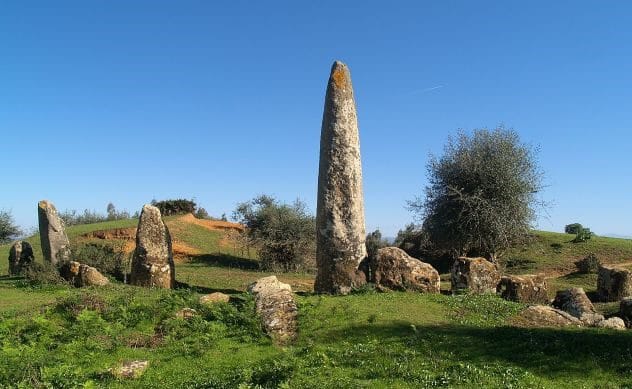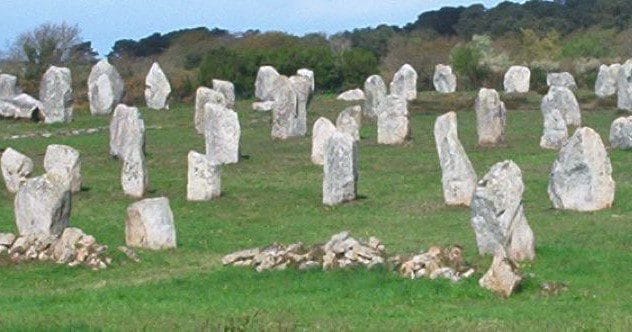The Stone Age stretches back an incredible 2.6 million years, covering over 98% of known human history and ending around 3000 BC. This vast period saw multiple ice ages and the emergence of modern humans. Amazingly, about 300,000 years ago, nine different human species lived on Earth at the same time, but only Homo sapiens survive today.
This ancient era is full of secrets. New archaeological finds keep changing what we thought we knew about early human culture, technology, and achievements. Yet, each discovery often brings more questions, making us rethink not only our past but also our present capabilities.
10. The Red Deer Cave People
In 2012, scientists were thrilled by the discovery of 14,000-year-old bones in China’s Maludong, or Red Deer Cave. These bones belonged to several members of a unique pre-modern human species. Archaeologists first thought they might be a completely new species or a very early group of modern humans who arrived in the area over 100,000 years ago. The puzzle of the “Red Deer Cave People” continues because it was believed that early pre-modern humans in Eurasia, like the Denisovans and Neanderthals, died out around 40,000 years ago, soon after modern humans appeared.
This find suggests a pre-modern species might have lived alongside modern humans in East Asia. These ancient people, or their remains, are so recent yet so different from us, raising big questions. Were they truly a separate human species? If so, what happened to them? Why did they vanish? How did they live, and how did they interact with our ancestors?
9. The Shigir Idol
Discovered in 1894 deep in a peat bog in Russia’s Ural Mountains, the Shigir Idol is an astonishing find. At 12,500 years old, it dates to the early Holocene epoch, often called the “Age of Man,” and is twice as old as Egypt’s pyramids. The idol is a marvel of preservation, carved from the wood of a 156-year-old Larch tree. Found in pieces, it was reconstructed to stand about 9 feet (2.75 meters) tall. However, drawings by archaeologist Vladimir Tolmachev suggest it was once over twice that height!
This massive artwork features seven faces: a three-dimensional face at the top and six more carved into its body. Abstract shapes like chevrons, herringbone patterns, and diagonal and horizontal lines run alongside the faces. Experts still haven’t figured out the message carved into the sculpture. It’s thought the geometric patterns had a specific meaning. Some theories propose the lines mark boundaries between the spiritual and physical worlds, or that it might be a pictorial map or related to ancient deities.
8. Stonehenge
Stonehenge, an icon of Stone Age engineering built even before the pyramids, has stood for millennia. Each of its 80 megaliths, some over 23 feet (7 meters) tall, weighs more than 20 tons. Construction began around 3100 BC. What we see today is only a fraction of the original site. But why did ancient people build these massive stone structures in the middle of the English countryside?
London archaeologist Mike Parker Pearson suggests that up to 10% of Great Britain’s population at the time visited the site to worship their gods. The discovery of 80,000 animal bones, possibly from feasts or offerings, supports this idea. While many theories exist, a popular one is that Stonehenge was an observatory, with the rising sun aligning perfectly through its core during the equinox. Others believe it was used for pagan rituals or as a burial ground. What’s certain is its immense importance, justifying the huge effort put into its construction.
7. The Carnac Stones
Hundreds of megalithic sites are spread across Carnac on Brittany’s south coast in France. Around 5000 BC, people in this region began erecting these massive stones, continuing for 2,000 years. This suggests a large, thriving, and well-organized society, given the scale and number of stones. The area, protected by the Quiberon Peninsula and rich with fresh-water springs, was ideal for hunting, fishing, and gathering.
However, the rise of agriculture, including animal domestication and crop cultivation, likely freed up people’s time, allowing them to build these enormous structures. But why? Some megaliths, dolmens (stone tunnels), and tumuli (dolmens buried under mounds), as well as single standing stones (menhirs), have been identified as graves. Yet, the purpose of the long stone lines (alignments), stone circles (cromlechs), and most menhirs remains unknown. Some think they were observatories or calendars for ancient farmers to track seasons. Priests might have used them to predict events like solar and lunar eclipses.
6. The Megalithic Menhirs of Mzora

Hidden in a remote part of Morocco, far from tourist trails, lies the Mzora stone ring. Also known as Msoura or Mezorah, it’s the world’s largest stone ellipse, located about 6.8 miles (11 kilometers) from Asilah. Mzora is barely mentioned in history, though Plutarch might have referred to it in his Life of Sertorius in the first century A.D.
This 10,000-year-old site has 168 surviving stones, out of an estimated original 175. The tallest stone reaches nearly 16.5 feet (5 meters). The only professional survey, by the Woods Hole Oceanographic Institute in the 1970s, revealed Mzora’s unique nature and its potential links to megalithic sites in Britain. Amazingly, Mzora seems to have been built by the same civilization that created sites in Ireland, France, and Britain. It aligns with stones at Stonehenge and Carnac and shares design principles, like the Pythagorean right-angled triangle (ratio 12-35-37) used in its ellipse, similar to British stone ellipses like Sands of Forvie and Daviot rings.
5. Malta’s Megalithic Mysteries
People first arrived on the Maltese islands about 7,000 years ago, likely from Sicily, though much about prehistoric Mediterranean movements is unknown. Then, around 3,400 BC, construction began on megalithic temples unlike any others, predating even the Great Pyramid and Stonehenge. These temples were built over a thousand years, showing distinct stylistic phases, with thirty sites existing today.
Malta is also home to the Hal Saflieni Hypogeum, one of the best-preserved underground chamber systems carved from rock. It’s thought several temples might have had similar structures beneath them, yet to be found. The Hal Saflieni Hypogeum consists of three main layers of subterranean rooms, pits, and galleries, with rock-cutting quality varying from rough to highly finished. The hypogeum has strange acoustic properties; sounds echo for a remarkably long time and reverberate throughout. Studies focused on the “oracle room,” with an oval wall niche producing intense echoes, suggest chanting was part of prehistoric ceremonies. The painted “disks” in this room grow larger towards the niche, hinting at its importance, another wonder from Malta’s ancient past.
4. The Tower of Jericho
The Tower of Jericho, one of humanity’s earliest stone monuments, has puzzled archaeologists since its discovery about 60 years ago. Built around 8000 BC next to the Wall of Jericho (found in 1907, tower in 1952), its purpose is debated. The people who built this tower, around 11,000 years ago, were established hunter-gatherers transitioning to agriculture. Unlike their ancestors, they couldn’t just pack up and leave during crises.
Some archaeologists think primitive concerns and cosmological beliefs influenced the tower’s construction. Others suggest the tower and wall were defenses, a landmark, or a display of wealth. Recently, two archaeologists from Tel Aviv University proposed a new theory: the 28-foot (8.5-meter) tower symbolized power and might. They observed that on the summer solstice, the longest day, the shadow of a western hill perfectly covered the Jericho Tower before engulfing the settlement. This implies a connection between the monument and the onset of longer nights.
3. Nabta Playa
Nabta Playa, a unique site in the Nubian Desert, about 62 miles (100 kilometers) west of Abu Simbel in southern Egypt, features hundreds of prehistoric tumuli, stelae, and megalithic structures. These are remnants of a highly developed urban community that arose around 11,000 years ago. This community built numerous megalithic monuments, including underground tombs, stone circles, massive stone slabs, and 8,200-feet-long (2,500-meter) rows of stelae. The megalithic monuments at Nabta Playa are among the world’s oldest, predating Stonehenge by millennia.
One of the most important monuments is a stone circle, declared by scientists as the world’s oldest known astronomical alignment of megaliths. Dating back at least 7,000 years, it served as a prehistoric calendar marking the summer solstice (linked to summer rains) and constellations used for desert navigation. What happened to the Nabta Playa people is a mystery. Some believe climate changes forced them to disperse, possibly migrating south into Nubia (modern Sudan) and north into Egypt. This exodus would have occurred before the rise of the first pharaohs, leading some to speculate that Nabta Playa is the true origin of Ancient Egyptian civilization.
2. The Age of the Great Sphinx
The Great Sphinx of Giza, the colossal stone figure with a lion’s body and a pharaoh’s head, is Egypt’s national symbol and a global landmark. Despite its fame, Egyptologists, archaeologists, and geologists continue to debate its “riddle”: How old is it? Popular belief holds that the monolith is about 4,500 years old, built for Khafre, a Fourth Dynasty pharaoh (reigned 2603–2578 BC).
However, not everyone agrees the Sphinx was built for Khafre. Since the mid-19th century, some Egyptologists noted that despite its location in Khafre’s pyramid complex, no contemporary inscriptions link him to the statue. Over time, researchers have attributed the Sphinx to Khafre’s father, Khufu, or another of Khufu’s sons, Djedefre. A newer theory places its origins much further back, around 9,000 years ago. Proponents point to significant limestone erosion on the Great Sphinx, arguing that the last time the region had enough rainfall to cause such deterioration was 7000 BC.
1. Göbekli Tepe
No list of Stone Age mysteries is complete without Göbekli Tepe, widely considered the world’s first temple. Located in southeastern Turkey, about 55 miles (88 kilometers) east of the upper Euphrates, the discovery of this 12,000-year-old site in 1994 shocked the archaeological world. It challenged the long-held theory that organized religion emerged only after cultures adopted agriculture. Early excavations led archaeologists to believe it was a ritual center, possibly a burial or death cult complex, not a settlement.
However, recent discoveries, like evidence of houses, a large water-harvesting system, and hundreds of milling tools, are rewriting prehistory again. Researchers used a computer algorithm to trace the architectural design of three massive round structures, finding that the pillars were deliberately placed. They discovered the site’s design features symbolic and spatial hierarchical levels, reflecting changes in the spiritual world and social structures of the time. This is remarkable because architectural design methods like floor plans and geometry were thought to have appeared much later. Göbekli Tepe was built 6,000 years before Stonehenge, and the exact meaning of its sculptures, architecture, and purpose remains a profound mystery, adding to its allure. Every new finding reshapes our understanding of the site and human history.
The Stone Age, despite its distance in time, continues to echo into our present. These lingering mysteries remind us of the ingenuity and complexity of our ancient ancestors. Each unanswered question invites us to keep digging, learning, and wondering about the dawn of human civilization.
What do you think is the most fascinating Stone Age mystery? Leave your comment below!










